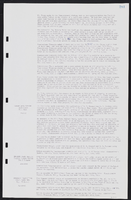Search the Special Collections and Archives Portal
Search Results
Riviera Hotel & Casino Publicity Collection and Architectural Records
Identifier
Abstract
The Riviera Hotel & Casino Publicity Collection and Architectural Records (1950s-2015) are comprised of entertainment, publicity and marketing files, and architectural drawings from the Riviera Hotel & Casino in Las Vegas, Nevada. The records include publicity photographs and videotapes, press kits, and information about various entertainers who appeared at the Riviera,publicity, promotional material, and newspaper clippings about events, and publicity photographs of restaurant and club venues within the hotel. Also included is information about the Riviera's longest running shows,
Archival Collection
MGM Mirage Records on Mandalay Resort Group
Identifier
Abstract
The MGM Mirage Records on Mandalay Resort Group consists of materials from Mandalay Resort Group’s office of public relations and community affairs records, which was closed after Mandalay’s corporate merger with MGM Mirage in 2005. The files, dating from 1968 to 2005, provide documentation of Mandalay Resort Group’s external affairs and internal operations. They contain subject files, photographs, negatives, slides, correspondence, VHS tapes, corporate publications, press releases, press kits, wholesale room agreements, hotel ephemera, employee newsletters, and press clippings. Of particular interest are files and photographs documenting the planning, development, construction, and opening of the Mandalay Resort Group properties.
Archival Collection

Transcript of interview with Phillip L. Cook by Richrad Strahan, March 3, 1977
Date
Archival Collection
Description
On March 3, 1977, Richard Strahan interviewed Phillip L. Cook (born 1939 in Las Vegas, Nevada) about his life in Southern Nevada. Cook first talks about his parents’ move to Nevada and then describes how the school system has changed over time. He then describes the first businesses that opened up in the Downtown and Strip areas in Las Vegas before discussing prostitution, Block 16, and recreational activities available to youth. Cook also talks about the first television sets and telephone systems made available, and he moves on to talk about the prices of things such as movies and haircuts when he was younger. The interview then moves to discussions on the Old Ranch, racial discrimination, school integration, the crime rate, and the school system in Las Vegas.
Text
Houssels, J. K., Jr. (John Kell), 1922-2017
John Kell Houssels Jr. was born in Denver, Colorado on December 11, 1922. His family moved to Las Vegas, Nevada when he was eight years old, and his father recieved one of Nevada's first gambling licenses. John Kell, also known as Ike, would follow in his father's footsteps and go on to help Las Vegas gain fame as an entertainment destination. After serving in the military and finishing his undergraduate education at West Point Military Academy in 1945, he went to law school at Stanford. After finishing his schooling, he returned to Las Vegas.
Person
Del Webb Corporation Photograph Collection
Identifier
Abstract
The Del Webb Corporation Photograph Collection (approximately 1957 to 1988) consists of black-and-white photographic prints, black-and-white oversize reprints, negatives, and color slides focusing on the Mint Hotel and Casino in downtown Las Vegas, Nevada. Images depict the construction of a twenty-six story high-rise addition to the property, its grand opening and anniversary celebrations, the Mint 400 Off-Road race festivities, interior shots of the casino floor, restaurants and lounges, and a salon. Also included are exterior images of properties on Fremont Street considered to be competitors of the Mint, advertisements and billboards, and photographs of Del E. Webb and associates.
Archival Collection
Claudine Williams oral history interview
Identifier
Abstract
Oral history interview with Claudine Williams conducted by Joanne Goodwin on November 20, 1997 and November 09, 2005 for the Women's Research Institute of Nevada (WRIN) Las Vegas Women Oral History Project. Goodwin begins the interview by discussing growing up in Shreveport, Louisiana, and how she supported her single mother. She goes on to describe her education and early jobs in restaurants and newsstands in Texas. Goodman then talks about meeting her husband, Shelby Williams, and how she became involved in the gaming industry, including her work with Benny Binion in Dallas, Texas and Jake Freidman in Houston, Texas. She describes moving to Las Vegas, Nevada in 1963, and how she and Shelby developed the Silver Slipper Casino, which was sold to Howard Hughes, and Holiday Casino, which eventually became Harrah's Hotel and Casino. Williams also speaks about her community involvement, including philanthropic efforts at the University of Nevada, Las Vegas.
Archival Collection

Film strip of Boulder City or Hoover Dam construction, image 011: photographic print
Date
Archival Collection
Description
Image

Loreta C. Monson interview, March 1, 1979: transcript
Date
Archival Collection
Description
On March 1, 1979, Jon J. Howard interviewed Loreta Monson (b. April 10, 1904 in Egypt, Idaho) about her life in Las Vegas, Nevada. Monson speaks about coming to Las Vegas, the layout of the city and Fremont Street. Moreover, Monson talks about the Mormon church in Las Vegas, politicians and Nellis Air Force Base. Lastly, Monson discusses leisure activities, recreational activities such as fishing, and the Old Ranch.
Text

Transcript of interview with Mike and Sallie Gordon by Adriane Massa, March 2, 1977
Date
Archival Collection
Description
Mike Gordon speaks about their liquor stores and lists his occupation as a bartender. Among the civic organizations that he participated in were: Young Democrats, Eagles Lodge, Lions Club, past president of Temple Beth Sholom and B'nai B'rith Lodge. Together Mike and Sallie recall the growth and changes of the valley they have witnessed between the early 1930s and mid-1970s. Among his anecdotes is one about the carrying of payroll checks to Boulder Dam to avoid "interference" (robberies).
Mike and Sallie were among the very first people of Jewish ancestry to make their way to Las Vegas. They arrived January 26, 1932 to join relatives of Sallie?s who had moved to Las Vegas when the Boulder Dam construction began. They had married in 1930 in Pittsburgh, Pennsylvania. Soon they were involved members of a small but growing group of Jewish pioneers and helped found Temple Beth Sholom, the community?s first synagogue. Mike speaks about their liquor stores and lists his occupation as a bartender. Among the civic organizations that he participated in were: Young Democrats, Eagles Lodge, Lions Club, past president of Temple Beth Sholom and B?nai B?rith Lodge. Together Mike and Sallie recall the growth and changes of the valley they have witnessed between the early 1930s and mid-1970s. Among his anecdotes is one about the carrying of payroll checks to Boulder Dam to avoid ?interference? (robberies).
Text

